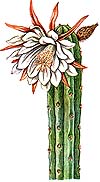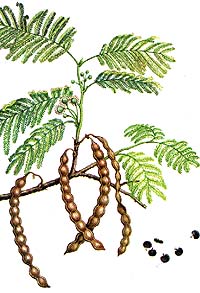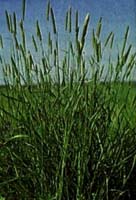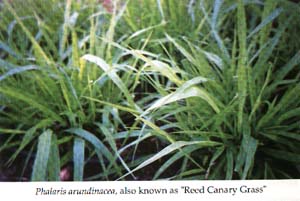Abu Zarga, M.H. 1986. Three new simple indole alkaloids from Limonia
acidissima. Lloydia 49(5), 901-904.
Akers, B.P. 1992. Peele's Lepiota: An identification and a clarification.
Mycotaxon 43(0), 461-469.
Arora, D. 1986. Mushrooms Demystified: A Comprehensive Guide to the Fleshy
Fungi. Ten Speed Press, Berkley.
Arthur, H.R., Loo, S.N. & Lamberton, J.A. 1967. Nb-methylated tryptamines
and other constituents of Acacia confusa Merr. of Hong Kong. Aust. J
Chem. 20, 811.
Banerjee, P.K. & Ghosal, S. 1969. Simple indole bases of Desmodium gangeticum.
Aust. J Chem. 22, 275-277.
Barrau, J. 1958.
Nouvelles observations au sujet des plantes hallucinogenes
d'usage autochtone en Nouvelle-Guinee. J Agric. Trop. Bot. Appl. 5, 377-378.
Barrau, J. 1962.
Observations et travaux recents sur les vegetaux
hallucinogenes de la Nouvelle-Guinee. J Agric. Trop. Bot. Appl. 9, 245-249.
Benedict, R.G., Brady, L.R., Smith, A.H. & Tyler, V.E. 1962.
Occurrence of
psilocybin and psilocin in certain Conocybe and Psilocybe species. Lloydia
25, 156-159.
Benedict, R.G., Tyler, V.E. & Watling, R. 1967.
Blueing in Conocybe, Psilocybe
and a Stropharia Species and the Dectection of Psilocybin. Lloydia 30(2),
150-157.
Besl, H. 1993.
Galerina steglichii spec. nov., a hallucinogenic Galerina.
Zeitschrift fuer Mykologie 59(2), 215-218.
Bresinsky, A. & Besl, H. 1990.
A Colour Atlas of Poisonous Fungi. Wolfe
Publishing Ltd, London.
Bye, R.A. 1979.
Hallucinogenic plants of the Tarahumara. J.
Ethnopharmacology 1, 23-48.
Christiansen, A.L., Rasmussen, K.E. & Hoeiland, K. 1984.
Detection of
psilocybin and psilocin in Norwegian species of Pluteus and Conocybe.
Planta Med. 50, 341-343.
Cimino, G. & De Stefano, S. 1978.
Chemistry of Mediterranean Gorgonians.
Simple indole derivatives from Paramuricea chamaeleon. Comptes Rendus
Biochem. Physiol. Ser. C. 61, 361-362.
Crouch, I.J., Smith M.T., Van Staden J., Lewis, M.J. & Hoad, G.V. 1992.
Identification of auxins in a commercial seaweed concentrate. J. Plant
Physiology 139(5), 590-594.
Daly, J.W. & Witkop, B. 1971.
Chemistry and pharmacology of frog venoms.
In Venomous animals and their venoms. Vol II. New York: Academic Press.
Davis, W. & Weil, A.T. 1992.
Identity of a New World Psychoactive Toad.
Ancient Mesoamerica 3 (1992) 5, 51-59.
De Moraes, E.H.F., Alvarenga, Z.M.A., Ferreira, Z.M.G.S. & Alisue, G.
1990.
Quim. Nova 13, 308.
Fitzgerald, J.S. & Sioumis, A.A. 1965.
Alkaloids of Australian
Leguminosae V. Aust. J Chem. 18, 433.
Fiussello, N. & Ceruti-Scarti, J. 1971/72.
Presenza di psilocibina edi
5-idrossi-indolderivati in Panaeolus retirugis. Atti Acc. Sci. Torino
106, 725-735.
Gartz, J. 1991.
Influence of phosphate on fruiting and secondary metabolism
of mycelia of Psilocybe cubensis, Psilocybe semilanceata and Gymnopilus
purpuratus. Zeitschrift fuer Mykologie 57(1), 149-154.
Ghosal, S., Chaudhuri, R.K., Dutta, S.K. & Bhattacharya, S.K. 1972.
Occurrence
of curaromimetic indoles in the flowers of Arundo donax. Planta Med. 21, 22.
Ghosal, S. & Mukherjee, B. 1966.
Indole-3-alkylamine Bases of Desmodium
pulchellum. J. Org. Chem. 31, 2284.
Ghosal, S., Singh, S. & Bhattacharya, S.K. 1971.
Alkaloids of Mucuna pruriens,
Chemistry and Pharmacology. Planta Med. 19, 279
Grina, J.A. et al. 1982.
Constituents of Zanthoxylum aborescens. Part 7. Old
& new alkaloids from Zanthoxylum aborescens. J. Organic Chemistry 47,
2648-2651.
Gurevich, L.S. 1993.
Indole derivatives in certain Panaeolus species from East
Europe & Siberia. Mycological Research 97(2), 251-254.
Gurevich, L.S. & Astapenko, V.V. 1992.
Chromatographic study of some indole
metabolites in Panaeolus basidiomycetes. Mikologiya I Fitopathologiga
26(3), 189-194.
Guzman, G. 1983.
The Genus Psilocybe. Beihefte Zur Nova Hedwingia 74, 1-439.
Guzman, G., Bandala, V.M. & Allen, J.W. 1993.
A New Bluing Psilocybe from
Thailand. Mycotaxon 26, 155-160.
Guzman, G., Bandala, V.M. & King, C. 1991.
A New Species of Psilocybe of Section
Zapotecorum from New Zealand. Mycological Research 95, 507-508.
Guzman, G., Saldarriaga, Y., Pineda, F., Garcia, G. & Velazquez, L.F. 1994.
New Species of Psilocybe from Colombia and Discussion on the known species.
Mycotaxon, 225.
Haeselbarth, G., Michaelis, H. & Salnikow, J. 1985.
Nachweis von Psilocybin in
Inocybe aeruginescens. Mykol. Mitt. bl. 28(1), 59-62.
Hatfield, G.M., Valdes, L.J. & Smith, A.H. 1978.
The occurrence of psilocybin
in Gymnopilus species. Lloydia 41, 140-144.
Hein, R. & Wasson, R.G. 1958.
Les champignons hallucinogenes du Mexique.
Museum National d'Histoire Naturelle, Paris.
Holmstedt, B., Lindgren, J.E., et al. 1980.
Indole alkaloids in Amazonian
Myristicaceae: Field and laboratory research. Bot. Mus. Leafl., Harvard
Univ. 28, 215-234.
Johns, S.R., Lamberton, J.A. & Sioumis, A.A. 1966.
Alkaloids of the
Australian Leguminosae VI. Aust. J. Chem. 19, 893.
Jossang, A., Jossang, C., Hadi, H.A., Sevenet, T. & Bodo, B. 1991.
Horsfiline, an oxindole alkaloid from Horsfieldia superba. J. Organic
Chem. 56(23), 6527-6530.
Kan Fan, C. et al. 1970.
Alcaloides de Vepris ampody (Rutacees). Phytochem.
9, 1283-1291.
Kantor, R.E., Dudlettes, S.D. & Shulgin, A.T. 1980.
5-Methoxy-alfa-methyl-tryptamine (alfa,O-dimethylserotonin), a hallucinogenic homolog of serotonin. Biological Psychiatry Vol 15, 349-352.
Koike, Y., Wada, K., Kusano, G., Nozoe, S., & Yokoyama, K. 1981.
Isolation
of Psilocybin from Psilocybe argentipes and its Determination in Specimens
of some Mushrooms. Lloydia 44(3), 362-365.
Leboeuf, M. et al., 1977.
Alkaloids and triterpenes of Testulea gabonensis.
Plant Medicine Phytotherapy 11, 230.
Luna, L.E. 1984.
The Healing Practices of a Peruvian Shaman. J.
Ethnopharmacology 11, 123-133.
McKenna, D.J., Towers, G.H.N., & Abbott, F. (1984).
Monoamine oxidase
inhibitors in South American hallucinogenic plants: Tryptamines and
Beta-carboline constituents of ayahuasca. J. Ethnopharmacology 10, 195-223.
Mckenna, D.J. & Towers, G.H.N. 1984.
Biochemistry and Pharmacology of
Tryptamines and beta-Carbolines: A Minireview. J. Psychoactive Drugs 16(4).
Meckes-Lozoya, M., Lozoya, X., Marles, R.J., Soucy-Breau, C., Sen, A. &
Arnason, J.T. 1990.
N,N-dimethyltryptamine alkaloid in Mimosa tenuiflora
bark (tepescohuite). Arch. Invest. Med. Mex. 21(2), 175-7.
Merlin, M.D. & Allen, J.W. 1993.
Species identification and chemical analysis
of psychoactive fungi in the Hawaiian islands. Journal of Ethnopharmacology
40(1), 21-40.
Miller Jr., O.K. 1972.
Mushrooms of North America. Dutton & Co., Springfield.
Most, Albert. 1984.
Bufo Alvarius: the Psychedelic Toad of the Sonoran Desert.
Venom Press Box 2863 Denton TX 76202.
Most, Albert. 1986.
Eros and the Pineal: the layman's guide to cerebral solitaire. Venom Press, Denton, TX.
Naranjo, C. 1969.
Psychotropic Properties of the Harmala Alkaloids. In: Efron
(Ed.) The Ethnopharmacologic Search for Psychoactive Drugs.
Ohenoja, E., Jokiranta, J., Makinen, T., Kaikkonen, A. & Airaksinen, M.M.
1987. The Occurrence of Psilocybin and Psilocin in Finnish Fungi. Lloydia
50(4), 741-744.
Pachter, I.J, Zacharias, D.E & Ribeir, O. 1959.
Indole Alkaloids of Acer
saccharinum (the Silever Maple), Dictyoloma incanescens, Piptadenia
colubrina, and Mimosa hostilis. J. Org. Chem. 24, 1285-7.
Phillips, R. 1981.
Mushrooms and other fungi of Great Britain and Europe.
Pan Books, London.
Poupat, C., Ahond, A. & Sevenet, T. 1976.
Alcaloides De Acaia simplicifolia.
Phytochemistry 15, 2019-2120.
Rivier, L. & Lindgren, J-E. 1972.
"Ayahuasca," the South American
Hallucinogenic Drink: an Ethnobotanical and Chemical Investigation.
Economic Botany 26, 101-129.
Rivier, L. & Pilet, P.E. 1971.
Annee Biologique 10, 129.
Robbers, J.E., Tyler, V.E. & Ola'h, G.M. 1969.
Additional evidence supporting
the occurrence of psilocybin in Panaeolus foenisecii. Lloydia 32, 399-400.
Rovelli, B. & Vaughan, G.N. 1967.
Alkaloids of Acacia I. Dimethyltryptamine
in Acacia phlebophylla. Aust. J. Chem. 20, 1299-1300.
Saupe, S.G. 1981.
Occurence of Psilocybin/Psilocin in Pluteus salicinus
(Pluteaceae). Mycologia 73, 781-784.
Schultes, R.E. 1976.
Indole Alkaloids in Plant Hallucinogens. J. of
Psychedelic Drugs Vol 8(1), 7-25.
Schultes, R.E. 1977.
The Botanical and Chemical Distribution of Hallucinogens.
J. of Psychedelic Drugs Vol 9(3), 247-263.
Schultes, R.E. 1979.
Hallucinogenic Plants: Their Earliest Botanical
Descriptions. J. of Psychedelic Drugs Vol 11(1-2), 13-24.
Schultes, R.E. & Hofmann, A. 1979.
Plants of the Gods. McGraw-Hill.
Reprint available from Healing Arts Press, Rochester, VT.
Schultes, R.E. & Hofmann, A. 1980.
The Botany and Chemistry of Hallucinogens.
Springfield, Ill: Thomas.
Shulgin, A.T. 1976.
Psychotomimetic agents. In: Gordon, M. (Ed.)
Psychopharmacological Agents, Vol IV. New York: Academic Press.
Shulgin, A.T. 1982.
Chemistry of Psychotomimetics. In: Hoffmeister, F. &
Stille, G. (Eds.) Handbook of Experimental Pharmacology, Vol 55:
Alcohol and Psychotomimetics, Psychotropic Effects of Central-Acting
Drugs. New York: Springer-Verlag.
Skaltsounis, A.L., Tillequin, F. & Koch, M. 1983.
Plantes des Nouvelle-
Caledonie LXXXIII: Alcaloides des tiges feuillees de Melicope leptococca.
Lloydia 46(5), 732.
Smith, T.A. 1977.
Review: Tryptamine and Related Compounds in Plants.
Phytochemistry 16 171-175.
Stein, S.I. 1959.
Clinical Observations on the Effects of Panaeolus
venenosus Versus Psilocybe caerulescens Mushrooms. Mycologica 51, 49.
Stijve, T., Klan, J. & Kugper, W. 1985.
Occurrence of psilocybin and
baeocystin in the genus Inocybe. Persoonia 12, 469-472.
Strassman, R.J. 1990.
The Pineal Gland: Current Evidence For Its Role In
Consciousness. In: Lyttle, T. (Ed.) Psychedelic Monographs and Essays
Vol 5.
Thompson, A.C., Nicollier, G.F. & Pope, D.F 1987.
Indolealkylamines of
Desmanthus illinoensis and Their Growth Inhibition Activity. J. Agric.
Food Chem. 35, 361-365.
Wahba, S.K. & Elkheir, Y.M. 1975.
Dimethyltyrptamine from the leaves of certain Acacia species of northern Sudan. Lloydia 38, 176-177.
Wassel, G.M. et al. 1985.
Alkaloids from the rhizomes of Phragmites
australis Cav. Scientia Pharmaceutica 53, 169-170.
Petrus.Pennanen@helsinki.fi * Everything is perfect forever
Michael from Melbourne * Ditto

 Monoamine oxidase (MAO) is the primary inactivation pathway of most
tryptamines. Because of this, inhibitors of the MAO enzyme (MAOIs) can be
used to potentiate the effects of tryptamines and to make DMT and 5-MeO-DMT
orally active.
Monoamine oxidase (MAO) is the primary inactivation pathway of most
tryptamines. Because of this, inhibitors of the MAO enzyme (MAOIs) can be
used to potentiate the effects of tryptamines and to make DMT and 5-MeO-DMT
orally active.
 MAO inhibitors fall into two classes: Irreversible and reversible MAOIs.
In addition they can inhibit either or both of the two types of the MAO
enzyme, MAO-A and MAO-B which are associated with serotonergic and
dopaminergic neurons respectively. Irreversible MAOIs (e.g. the hydrazides
iproniazid and phenelzine) bind permanently to the enzyme and cause MAO
inhibition lasting 1-2 weeks after ingestion. They are used clinically to
treat depression. Reversible MAOIs, such as moclobemide, which is used as an
antidepressant, and the beta-carbolines harmine and harmaline, are effective
for much shorter time, maybe up to 24 hours. Recreational drug users around
the world are using mainly harmine and harmaline despite the lack of
scientific studies on their effects on humans.
MAO inhibitors fall into two classes: Irreversible and reversible MAOIs.
In addition they can inhibit either or both of the two types of the MAO
enzyme, MAO-A and MAO-B which are associated with serotonergic and
dopaminergic neurons respectively. Irreversible MAOIs (e.g. the hydrazides
iproniazid and phenelzine) bind permanently to the enzyme and cause MAO
inhibition lasting 1-2 weeks after ingestion. They are used clinically to
treat depression. Reversible MAOIs, such as moclobemide, which is used as an
antidepressant, and the beta-carbolines harmine and harmaline, are effective
for much shorter time, maybe up to 24 hours. Recreational drug users around
the world are using mainly harmine and harmaline despite the lack of
scientific studies on their effects on humans.


 Peganum harmala (Syrian rue) seeds are the most concentrated natural source
of harmine and harmaline—about 3% of their weight consists of these
alkaloids. Banisteriopsis caapi has been found to contain from 0.18% to
1.36% beta-carbolines, with the concentration of harmine being from 0.057%
to 0.635% (
Peganum harmala (Syrian rue) seeds are the most concentrated natural source
of harmine and harmaline—about 3% of their weight consists of these
alkaloids. Banisteriopsis caapi has been found to contain from 0.18% to
1.36% beta-carbolines, with the concentration of harmine being from 0.057%
to 0.635% (











